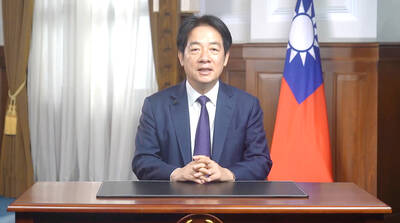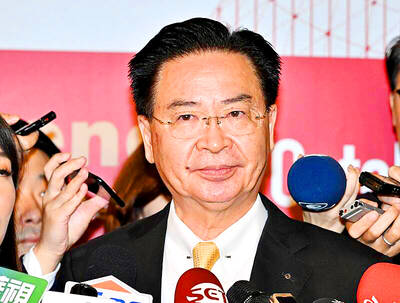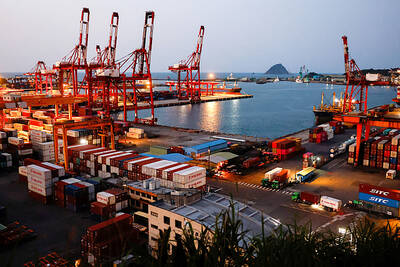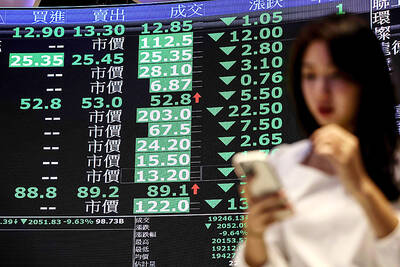The Han Kuang exercises, Taiwan’s largest annual military drills, began yesterday, with experts saying that the extended 14 days of war games were in response to China’s increasing “gray zone” activities and its potential to carry out a full-scale invasion of Taiwan.
This year’s exercises started with around-the-clock computer-aided war games, using the US-built Joint Theater Level Simulation platform.
The live-fire component of the exercises is to be held from July 9 to 18.

Photo: CNA
The drills are to create scenarios in which Chinese People’s Liberation Army (PLA) military exercises escalate into an attack on Taiwan, said Major General Tung Chi-hsing (董冀星), director of the Ministry of National Defense’s joint operations planning division.
The Han Kuang exercises would also simulate PLA “gray zone” activities, which are provocative or aggressive actions that fall just short of an open conflict, Tung told a news conference on Wednesday.
Democratic Progressive Party Legislator Wang Ting-yu (王定宇) on Friday said that the public used to think that a first strike by China would likely come in the form of a missile attack.
However, it is more realistic to think that a first strike would involve maritime militia vessels, sand dredgers and drones, which are commonly used in “gray zone” operations, he said.
Wang, a member of the legislature’s Foreign Affairs and National Defense Committee, said the military has to consider how to deal with situations that go beyond traditional force-on-force confrontations.
These include how to respond to “gray zone” activities within the bounds of international law, while preventing Chinese military drills from escalating into a full-scale invasion, he said.
Such complex scenarios require detailed planning and simulation, making the war games more time-consuming, he said.
Su Tzu-yun (蘇紫雲), director of the Division of Defense Strategy and Resources at the Institute for National Defense and Security Research, expressed similar views, saying that the Han Kuang drills were likely extended this year from eight days to two weeks to facilitate more scenarios involving “gray zone” tactics.
When the PLA is conducting its naval and air patrols around Taiwan, it usually deploys six to 10 warships, Su said, adding that if each of them were equipped with vertical launching systems, there could be about 500 land-attack cruise missiles ready to strike targets across Taiwan within three minutes.
That would leave defense forces with even less response time than if Dongfeng (East Wind, 東風) missiles were launched across the Taiwan Strait from China, he said.
That makes simulating such scenarios critically important, particularly as PLA drills near Taiwan have become more frequent in the past few years, he added.
Minister of National Defense Minister Wellington Koo (顧立雄) in a recent legislative hearing said this year’s Han Kuang exercises would be based on a hypothetical invasion by the PLA in 2027, Su said.
That year would mark several milestones in China, such as the 100th anniversary of the PLA’s founding, the start of Chinese President Xi Jinping’s (習近平) fourth term in office and the 12th year of Xi’s military reforms, he said.
This year’s exercises would test how the Ministry of National Defense would respond in the event of a 2027 invasion and assess any shortcomings in the armed forces’ readiness and arsenal of weapons, Su said.

ACTION PLAN: Taiwan would expand procurement from the US and encourage more companies to invest in the US to deepen bilateral cooperation, Lai said The government would not impose reciprocal tariffs in retaliation against US levies, President William Lai (賴清德) said yesterday, as he announced five strategies to address the issue, including pledging to increase Taiwanese companies’ investments in the US. Lai has in the past few days met with administrative and national security officials, as well as representatives from various industries, to explore countermeasures after US President Donald Trump on Wednesday last week announced a 32 percent duty on Taiwanese imports. In a video released yesterday evening, Lai said that Taiwan would not retaliate against the US with higher tariffs and Taiwanese companies’ commitments to

‘SPECIAL CHANNEL’: Taipei’s most important tasks are to stabilize industries affected by Trump’s trade tariffs and keep negotiations with Washington open, a source said National Security Council Secretary-General Joseph Wu (吳釗燮) arrived in the US for talks with US President Donald Trump’s administration, a source familiar with the matter said on Friday. Wu was leading a delegation for a meeting known as the “special channel,” the Financial Times reported earlier. It marked Trump’s first use of the channel since returning to the White House on Jan. 20. Citing a source familiar with the matter, the Financial Times reported that Minister of Foreign Affairs Lin Chia-lung (林佳龍) was also a part of the delegation. The visit came days after China concluded war games around Taiwan and amid Trump’s

CHIP EXCEPTION: An official said that an exception for Taiwanese semiconductors would have a limited effect, as most are packaged in third nations before being sold The Executive Yuan yesterday decried US President Donald Trump’s 32 percent tariff on Taiwanese goods announced hours earlier as “unfair,” saying it would lodge a representation with Washington. The Cabinet in a statement described the pledged US tariffs, expected to take effect on Wednesday next week, as “deeply unreasonable” and “highly regrettable.” Cabinet spokeswoman Michelle Lee (李慧芝) said that the government would “lodge a solemn representation” with the US Trade Representative and continue negotiating with Washington to “ensure the interests of our nation and industries.” Trump at a news conference in Washington on Wednesday announced a 10 percent baseline tariff on most goods

HELPING HAND: The steering committee of the National Stabilization Fund is expected to hold a meeting to discuss how and when to utilize the fund to help buffer the sell-off The TAIEX plunged 2,065.87 points, or 9.7 percent, to close at 19,232.35 yesterday, the highest single-day percentage loss on record, as investors braced for US President Donald Trump’s tariffs after an extended holiday weekend. Amid the pessimistic atmosphere, 945 listed companies led by large-cap stocks — including Taiwan Semiconductor Manufacturing Co (TSMC, 台積電), Hon Hai Precision Industry Co (鴻海精密) and Largan Precision Co (大立光) — fell by the daily maximum of 10 percent at the close, Taiwan Stock Exchange data showed. The number of listed companies ending limit-down set a new record, the exchange said. The TAIEX plunged by daily maxiumu in just